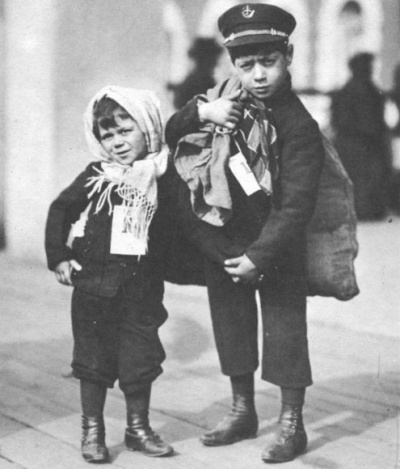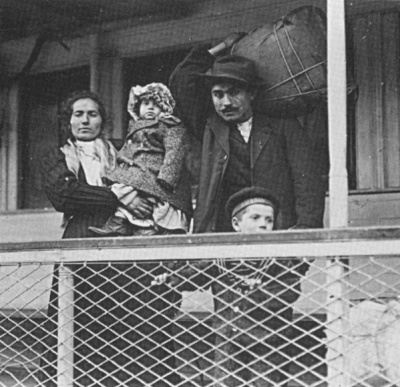From The Peopling of New York City
Italians, Irish, and African Americans in New York City
The Italians
Foner noted that a tremendous amount of Italians immigrated to the United States. A table by Frank J. Cavaioli proves this fact: Italian Immigration to the United States as Recorded by Country of Birth and Country or Region of Last Residence:1820-2004: FROM PATTERNS OF ITALIAN IMMIGRATION TO THE UNITED STATES BY Frank J.Cavaioli
| 1820: 30 | 1931-1940: 68,028 |
| 1821-1830: 409 | 1941-1950: 57,661 |
| 1831-1840: 2,253 | 1951-1960: 185,491 |
| 1841-1850: 1,870 | 1961-1970: 214,111 |
| 1851-1860: 9,231 | 1971-1980: 129,368 |
| 1861-1870: 11,725 | 1981-1990: 67,254 |
| 1871-1880: 55,759 | 1991-2000: 62,722 |
| 1881-1890: 307,309 | 2001: 3,377 |
| 1891-1900: 651,893 | 2002: 2,837 |
| 1901-1910: 2,045,877 | 2003: 1,904 |
| 1911-1920: 1,109,524 | 2004: 2,495 |
These Italian immigrants have come a long way; back in the early 20th century Italians were at the bottom of every ladder possible. Many Americans harbored a great dislike for the Italian culture and the Italian people. However, now we see that the Italian culture has been immersed in American society. Italian influeneces such as: pasta, pizza, mobster movies, and following the various soccer teams of Italy have become staples in American life.
Back in the day, an Italian family such as the Molino’s would have had a workman father, a homemaker mother, and kids that were seen as troublemakers. As such, little respect would have been given to such a family and they would often be living in poverty. In fact, wages for Italians would often be less than those of ‘whites’ and the ‘colored’. (Foner 148)
Somewhere along the way though, Italians became Americanized, or in other words, they became accepted by society and their culture meshed with American culture. These Italians came to fit the category of ‘white’. Now many Italians are very prosperous; the Molino name today could probably be seen on a fancy restaurant or on a mailbox in a well-off neighborhood such as Howard Beach.
As Nancy Foner shows, Italian immigration documents how light-colored ethnic groups such as the Italians and Jews were able to achieve a higher status in society over the years because society came to see these groups as fitting under the umbrella of ‘Caucasian’.
The African Americans
In order to study the African Americans in terms of their history in New York City, I researched the book “Beyond the Melting Pot” by Nathan Glazer and Daniel P. Moynihan. Writing their book in the 1960’s, Glazer and Moynihan wrote about their roles in society and how they assimilated in the American culture at around that period. Glazer and Moynihan discuss their population in New York City, what kind of jobs they had, education, housing, politics, and more.
Glazer and Moynihan start by talking about the numbers, or the population, of the African Americans in New York City. In 1960, around the time that they wrote the book, there were 1,088,000 African Americans in New York City. This was a huge increase because this was an increase of about 340,000 since 1950. At the same time, NYC’s white population dropped about 500,000, which made the African Americans populate one-seventh of the whole city by 1960. Not only this, the African American population was younger than the Caucasian population, which made the school population be filled with African Americans (along with the Puerto Ricans).
The next topic covered is the jobs and salaries that these African Americans had in New York City. Compared to the Caucasian workers, there was a huge gap between them in terms of salary in New York City. During the depression for example, the African American workers made a little more than 60% of what the Caucasian workers were making, and these white workers barely got paid enough to survive. However, it was a little better for women in the lower levels of skill during the 1960’s because there were better jobs for women than for men. While the black women were 93% compared to white women, for black men it was only 68% compared to white men. Even for the professional jobs that the African American men had, it was hard for them because they were slow in their growth.
For the African Americans’ education, there is not a great outcome percentage although these African Americans put a high value on education. In 1960, one-fourth of the NYC elementary school population was African American, and only a tenth of the high school population was African American. However, the graduation rate among them is lower than 10%. Glazer and Moynihan talks of how African American girls do better than the boys because many of them looks at school and education as an attack to their masculinity. This problem leads for many problems in the family. Since these African American boys do not get a good education and do not learn, one-fourth of the total African American families in NYC were headed by women.
The next topic concerning the African Americans in New York City is the housing, and the huge gap compared to the whites in their conditions of life. Although there are laws against discrimination in housing, it is hard for the city to enforce these laws because the apartments are owned by small landlords and not by big organizations. The city’s laws not only try to improve housing for these African Americans, they are also trying to end the pattern of segregation even among the small landlords.
The last topic Glazer and Moynihan talks about the African Americans in this book are the leadership, politics, and intergroup relations in New York City. The African Americans in the NYC communities tend to get very involved with politics because of their group interests. They vote for representatives who will allow them to get better jobs and better conditions for housing which remains to be the biggest problem for African Americans. They also want more political jobs and representation in government. Concerning intergroup relations, African Americans tend to have anti-Jewish feelings because these Jews are always ahead of them. The African Americans are the customers of the Jewish shopkeepers, they are the tenants of Jewish landlords, and they are the employees of the Jewish bosses. The African American relationships with the Jews are the same with them and the Italians and the Irish.
African Americans at this time (the 1960’s) were still having much trouble as Glazer and Moynihan portrayed in their book. They did not have great jobs, salaries, education, had family problems, bad housing, and not great political representation. Glazer and Moynihan well described their ways of living in New York City. As they had to live with the Caucasian majority, they had a tough time living with them but they stilled pulled through even though many things were not in their favor.


